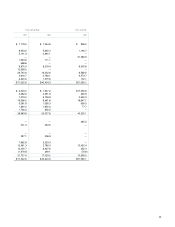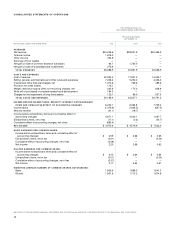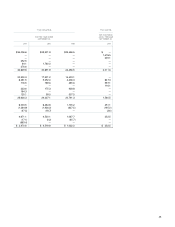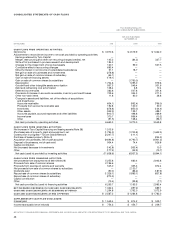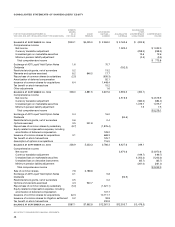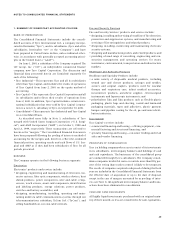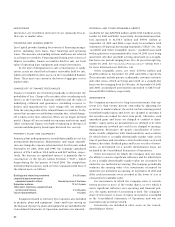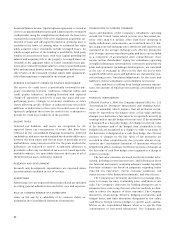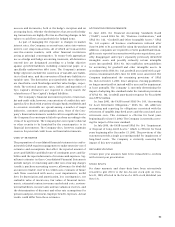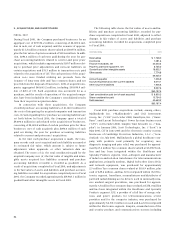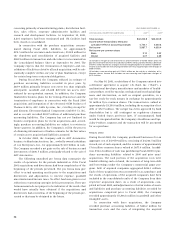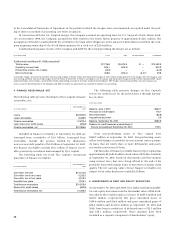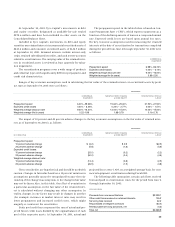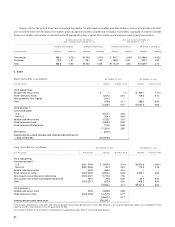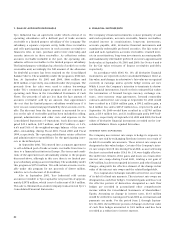ADT 2001 Annual Report Download - page 55
Download and view the complete annual report
Please find page 55 of the 2001 ADT annual report below. You can navigate through the pages in the report by either clicking on the pages listed below, or by using the keyword search tool below to find specific information within the annual report.
53
assesses and documents, both at the hedge’s inception and on
an ongoing basis, whether the derivatives that are used in hedg-
ing transactions are highly effective in offsetting changes in fair
values or cash flows associated with the hedged items.
As part of managing the exposure to changes in market
interest rates, the Company, as an end-user, enters into various
interest rate swap transactions, all of which are transacted in
over-the-counter markets, with other financial institutions
acting as principal counterparties. To ensure both appropriate
use as a hedge and hedge accounting treatment, all derivatives
entered into are designated according to a hedge objective
against specified liabilities including commercial paper, or a
specifically underwritten debt issue. The Company’s primary
hedge objectives include the conversion of variable-rate liabili-
ties to fixed rates, and the conversion of fixed-rate liabilities to
variable rates. The derivatives associated with these objectives
are classified as cash flow hedges and fair value hedges, respec-
tively. The notional amounts, rates, indices and maturities of
Tyco Capital’s derivatives are required to closely match the
related terms of Tyco Capital’s hedged liabilities.
The Company’s financial instruments present certain mar-
ket and credit risks; however, concentration of credit risk is mit-
igated as Tyco deals with a variety of major banks worldwide and
its accounts receivable are spread among a number of major
industries, customers and geographic areas. None of the Com-
pany’s financial instruments would result in a significant loss to
the Company if a counterparty failed to perform according to the
terms of its agreement. The Company does not require collateral
or other security to be furnished by the counterparties to its
financial instruments. The Company does, however, maintain
reserves for potential credit losses on financial instruments.
USES OF ESTIMATES
The preparation of consolidated financial statements in confor-
mity with GAAP requires management to make extensive use of
estimates and assumptions that affect the reported amount of
assets and liabilities and disclosure of contingent assets and lia-
bilities and the reported amounts of revenues and expenses. Sig-
nificant estimates in these Consolidated Financial Statements
include merger, restructuring and other non-recurring charges
(credits), purchase accounting reserves, allowances for doubtful
accounts receivable, reserve for credit losses, estimates of future
cash flows associated with assets, asset impairments, useful
lives for depreciation and amortization, loss contingencies, net
realizable value of inventories, fair values of financial instru-
ments, estimated contract revenues and related costs, environ-
mental liabilities, income taxes and tax valuation reserves, and
the determination of discount and other rate assumptions for
pension and post-retirement employee benefit expenses. Actual
results could differ from these estimates.
ACCOUNTING PRONOUCEMENTS
In June 2001, the Financial Accounting Standards Board
(“FASB”) issued SFAS No. 141, “Business Combinations,” and
SFAS No. 142, “Goodwill and Other Intangible Assets.” SFAS
No. 141 requires all business combinations initiated after
June 30, 2001 to be accounted for using the purchase method. In
addition, companies are required to review goodwill and intan-
gible assets reported in connection with prior acquisitions, pos-
sibly disaggregate and report separately previously identified
intangible assets and possibly reclassify certain intangible
assets into goodwill. SFAS No. 142 establishes new guidelines
for accounting for goodwill and other intangible assets. In
accordance with SFAS No. 142, goodwill associated with acqui-
sitions consummated after June 30, 2001 is not amortized. The
Company implemented the remaining provisions of SFAS
No. 142 on October 1, 2001. Since adoption, existing goodwill is
no longer amortized but instead will be assessed for impairment
at least annually. The Company is currently determining the
impact of adopting this standard under the transition provisions
of SFAS No. 142. Goodwill amortization expense for Fiscal 2001
was $597.2 million.
In June 2001, the FASB issued SFAS No. 143, “Accounting
for Asset Retirement Obligations.” SFAS No. 143, addresses
accounting and reporting for obligations associated with the
retirement of tangible long-lived assets and the associated asset
retirement costs. This statement is effective for fiscal years
beginning after June 15, 2002. The Company is currently assess-
ing the impact of this new standard.
In July 2001, the FASB issued SFAS No. 144, “Impairment
or Disposal of Long-Lived Assets,” which is effective for fiscal
years beginning after December 15, 2001. The provisions of this
statement provide a single accounting model for impairment of
long-lived assets. The Company is currently assessing the
impact of this new standard.
RECLASSIFICATIONS
Certain prior year amounts have been reclassified to conform
with current year presentation.
STOCK SPLITS
Per share amounts and share data have been retroactively
restated to give effect to the two-for-one stock split on Octo-
ber 21, 1999, effected in the form of a 100% stock dividend (see
Note 13).


